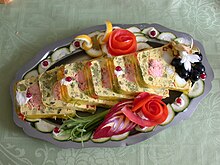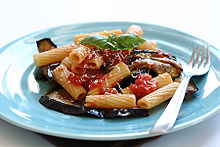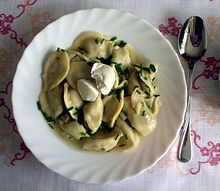List of European cuisines: Difference between revisions
→References: + {{cuisine}} {{European topic|| cuisine}} |
Copy attribution: merged content to this article from Global cuisine |
||
| Line 1: | Line 1: | ||
[[File:locationEurope.png|right|250px]] |
[[File:locationEurope.png|right|250px]] |
||
This is a '''[[list of European cuisines]]'''. A [[cuisine]] is a characteristic style of [[cooking]] practices and traditions,<ref>[http://www.thefreedictionary.com/cuisine "Cuisine."] [http://www.thefreedictionary.com Thefreedictionary.com]. Accessed June 2011.</ref> often associated with a specific [[culture]]. '''[[European cuisine]]''' (also called "Western cuisine") refers collectively to the cuisines of [[Europe]] and other [[Western world|Western countries]]. European cuisine includes cuisines of [[Europe]] |
This is a '''[[list of European cuisines]]'''. A [[cuisine]] is a characteristic style of [[cooking]] practices and traditions,<ref>[http://www.thefreedictionary.com/cuisine "Cuisine."] [http://www.thefreedictionary.com Thefreedictionary.com]. Accessed June 2011.</ref> often associated with a specific [[culture]]. '''[[European cuisine]]''' (also called "Western cuisine") refers collectively to the cuisines of [[Europe]] and other [[Western world|Western countries]].<ref name="europeword">[http://www.europeword.com/blog/europe/european-cuisine/ "European Cuisine."] [http://www.europeword.com Europeword.com]. Accessed July 2011.</ref> European cuisine includes cuisines of [[Europe]], including (depending on the definition) that of [[Russia]],<ref name="europeword"/> as well as non-[[Indigenous people|indigenous]] cuisines of [[North America]], [[Australasia]], [[Oceania]], and [[Latin America]], which derive substantial influence from European settlers in those regions. The term is used by [[East Asia]]ns to contrast with Asian styles of cooking.<ref name="Leung">Leung Man-tao (12 February 2007), "Eating and Cultural Stereotypes", ''Eat and Travel Weekly'', no. 312, p. 76. Hong Kong<!--: PUBLISHER HERE--></ref> This is analogous to Westerners referring collectively to the cuisines of Asian countries as [[Asian cuisine]]. When used by Westerners, the term may refer more specifically to cuisine ''in'' Europe; in this context, a synonym is '''[[Continental Europe|Continental]] cuisine''', especially in [[British English]]. |
||
:* [[Old World wine]] |
|||
The cuisines of Western countries are diverse by themselves, although there are common characteristics that distinguishes Western cooking from cuisines of Asian countries<ref name="Kwan 1988">Kwan Shuk-yan (1988). ''Selected Occidental Cookeries and Delicacies'', p. 23. Hong Kong: Food Paradise Pub. Co.</ref> and others. Compared with traditional cooking of Asian countries, for example, meat is more prominent and substantial in serving-size.<ref name="Lin 1977">Lin Ch'ing (1977). ''First Steps to European Cooking'', p. 5. Hong Kong: Wan Li Pub. Co.</ref> [[Wheat]]-flour bread has long been the most common sources of [[starch]] in this cuisine, along with [[pasta]], [[dumpling]]s and [[Pastry|pastries]], although the potato has become a major starch plant in the diet of Europeans and their diaspora since the [[European colonization of the Americas]]. |
|||
==== Northern European cuisine ==== |
==== Northern European cuisine ==== |
||
Revision as of 19:13, 26 May 2013

This is a list of European cuisines. A cuisine is a characteristic style of cooking practices and traditions,[1] often associated with a specific culture. European cuisine (also called "Western cuisine") refers collectively to the cuisines of Europe and other Western countries.[2] European cuisine includes cuisines of Europe, including (depending on the definition) that of Russia,[2] as well as non-indigenous cuisines of North America, Australasia, Oceania, and Latin America, which derive substantial influence from European settlers in those regions. The term is used by East Asians to contrast with Asian styles of cooking.[3] This is analogous to Westerners referring collectively to the cuisines of Asian countries as Asian cuisine. When used by Westerners, the term may refer more specifically to cuisine in Europe; in this context, a synonym is Continental cuisine, especially in British English.
The cuisines of Western countries are diverse by themselves, although there are common characteristics that distinguishes Western cooking from cuisines of Asian countries[4] and others. Compared with traditional cooking of Asian countries, for example, meat is more prominent and substantial in serving-size.[5] Wheat-flour bread has long been the most common sources of starch in this cuisine, along with pasta, dumplings and pastries, although the potato has become a major starch plant in the diet of Europeans and their diaspora since the European colonization of the Americas.
Northern European cuisine

- Cuisines of the British Isles
- Irish cuisine
- British cuisine is the specific set of cooking traditions and practices associated with the United Kingdom. British cuisine has been described as "unfussy dishes made with quality local ingredients, matched with simple sauces to accentuate flavour, rather than disguise it."[7] However, British cuisine has absorbed the cultural influence of those that have settled in Britain, producing hybrid dishes, such as the Anglo-Indian chicken tikka masala."[8][9]
- English cuisine
- Scottish cuisine is the specific set of cooking traditions and practices associated with Scotland. It has distinctive attributes and recipes of its own, but shares much with wider European cuisine as a result of foreign and local influences both ancient and modern. Scotland's natural larder of game, dairy, fish, fruit, and vegetables is the integral factor in traditional Scottish cooking. Scotland, with its temperate climate and abundance of indigenous game species, has provided a cornucopia of food for its inhabitants for millennia. The wealth of seafood available on and off the coasts provided the earliest settlers with their sustenance. Agriculture was introduced, with primitive oats quickly becoming the staple.
- Welsh cuisine
- Cuisine of Saint Helena
- Anglo-Indian cuisine
- Balti cuisine
- Wine from the United Kingdom
- Regional foods
- Scandinavian cuisines
- Danish cuisine

- Greenlandic cuisine is traditionally based on meat from marine mammals, game, birds, and fish, and normally contains high levels of protein. Since colonization and the arrival of international trade, the cuisine has been increasingly influenced by Danish and Canadian cuisine.[10] Since the majority of Greenland is covered by permanent glaciers, the sea is the source of most domestically sourced food.[11] Seafood dishes include various fishes (often smoked), mussels, and shrimp. Ammassat or capelin, a fish in the salmon family is commonly consumed.[12] The national dish of Greenland is suaasat, a traditional Greenlandic soup.[13] It is often made from seal, or from whale, reindeer, or sea birds. The soup often includes onions and potatoes, and is simply seasoned with salt and pepper, or bay leaf. The soup is often thickened with rice, or by soaking barley in the water overnight so that the starches leach into the water. During the summer, meals are often eaten outdoors.[12]
- Northern European foods and dishes
Western European cuisine

- Regional cuisines
- Regional Dutch cuisines can be distinguished by three geographic regions in The Netherlands, northeastern, western and southern cuisine.[18]
- German regional cuisine can be divided into Bavarian cuisine (Southern Germany), Lower Saxon cuisine (Northern Germany), Thuringian (Central Germany)[19] and Saxony-Anhalt (Central Germany).
Central and Eastern European cuisine

- Cuisines of Central Europe
- Austrian cuisine is a style of cuisine native to Austria and composed of influences from throughout the former Austro-Hungarian Empire.[20] Regional influences from Italy, Hungary, Germany and the Balkans have had an effect on Austrian cooking, and in turn this fusion of styles was influential throughout the Empire.[21]
- Cuisines of Eastern Europe
- Russian cuisine is diverse, as Russia is the largest country in the world.[22] Russia's great expansions of territory, influence, and interest during the 16th–18th centuries brought more refined foods and culinary techniques, as well as one of the most refined food countries in the world. It was during this period that smoked meats and fish, pastry cooking, salads and green vegetables, chocolate, ice cream, wine, and liquor were imported from abroad. At least for the urban aristocracy and provincial gentry, this opened the doors for the creative integration of these new foodstuffs with traditional Russian dishes. The result is extremely varied in technique, seasoning, and combination. Traditional and common Russian foods include:
- Beer[23]
- Blini, a pastry rolled with a variety of ingredients[23]
- Borshch, a traditional Russian beet soup[23]
- Caviar[23]
- Crêpe[23]
- Ice cream[23]
- Pelmeni, pastry dumplings filled with minced meat[23]
- Pirozhki, pastries filled with potato, cabbage, meat or cheese[23]
- Shashlyk, Russian kebab[23]
- Sour cream[23]
- Russian vodka[23]

Southern European cuisine


- French regional cuisine is characterized by its extreme diversity and style. Traditionally, each region of France has its own distinctive cuisine.[24] French cuisine styles include Nouvelle cuisine, Haute cuisine and Cuisine classique. In November 2010 the French gastronomy was added by UNESCO to its lists of the world's "intangible cultural heritage".[25][26]
- Cuisines of the Balkans
- Albanian cuisine is uniquely influenced by Turkish, Greek, and Italian cuisines. Every region in Albania has its own unique dishes. Albanian cuisine is characterized by the use of various Mediterranean herbs such as oregano, black pepper, mint, basilico, rosemary and more in cooking meat and fish.
- Greek wine
- Macedonian cuisine (Greek)
- Regional foods
- Taramosalata, a Greek meze made with salted and cured fish roe.[27]
- Cuisines of the Italian Peninsula
- Italian cuisine - presents popular dishes like Pizza, Pasta, Lasagne, Mozzarella and other well-known food. Italian cuisine has been influenced by Ancient Greek, Ancient Roman, Etruscan cuisines and dates back to 4th century BCE. It maintains strong regional diversity and it uses a vast variety of ingredients, mostly because of the political divisions in Italian history and different climate and resources in the country. Most of the dishes are simple to prepare and not expensive, which is one of the reason it is very popular around the world.

- Italian wine
- Regional Cuisines - in Italian cuisine, each area has its own specialties, primarily at the regional level, but also at provincial levels.[28][29][30] The cuisine has an abundance of differences in taste, and is known to be one of the most popular in the world,[31] with influences abroad.[32] The differences can derive from a bordering country (such as France or Austria), whether a region is close to the sea or the mountains, and economics. Italian cuisine is also seasonal, often incorporating fresh produce. Italian regional cuisines include:
- Abruzzo and Molise
- Basilicatan
- Calabrian
- Emilia-Romagnan
- Friuli-Venezia Giulia
- Lazio
- Ligurian
- Lombardy
- Marche
- Neapolitan cuisine, Campania
- Piedmontese
- Puglian
- Sardinian cuisine
- Sicilian cuisine
- Trentino-Alto Adige/South Tyrol
- Tuscan cuisine
- Umbrian
- Valle d'Aostan
- Venetian cuisine
- Cuisines of the Iberian Peninsula
- Gibraltarian cuisine
- Portuguese cuisine
- Spanish cuisine has a variety of dishes including thousands of recipes and flavors arising from Spain's extensive history with many cultural influences, and variations in geography and climate. It is heavily influenced by seafood available from the waters that surround the country, and reflects the country's deep maritime roots. Spanish wine is a significant part of Spanish cuisine. Regional Spanish cuisines include:
- Southern European foods and dishes
-
A variety of tapas: appetizers or snacks in Spanish cuisine
See also
References
- ^ "Cuisine." Thefreedictionary.com. Accessed June 2011.
- ^ a b "European Cuisine." Europeword.com. Accessed July 2011.
- ^ Leung Man-tao (12 February 2007), "Eating and Cultural Stereotypes", Eat and Travel Weekly, no. 312, p. 76. Hong Kong
- ^ Kwan Shuk-yan (1988). Selected Occidental Cookeries and Delicacies, p. 23. Hong Kong: Food Paradise Pub. Co.
- ^ Lin Ch'ing (1977). First Steps to European Cooking, p. 5. Hong Kong: Wan Li Pub. Co.
- ^ Home Cooking: Traditional Irish Stew
- ^ UKTV. "British cuisine". uktv.co.uk. Retrieved 2008-05-23.
- ^ "Robin Cook's chicken tikka masala speech". London: The Guardian. 2002-02-25. Retrieved 2001-04-19.
{{cite news}}: Italic or bold markup not allowed in:|publisher=(help) - ^ BBC E-Cyclopedia (20 April 2001). "Chicken tikka masala: Spice and easy does it". bbc.co.uk. Retrieved 28 September 2007.
{{cite news}}: External link in|work= - ^ "Greenlandic cuisine." Official Greenland Tourism Guide. (retrieved Oct 30, 2010)
- ^ Kleivan, "Greenland Eskimo," 522
- ^ a b "Traditional Greenlandic food." Official Greenland Tourism Guide. (retrieved Oct 30, 2010)
- ^ "Recipes of Greenlandic Cuisine." Colonial Voyage. (retrieved Oct 31, 2010)
- ^ Public House Britannica.com; Subscription Required. Retrieved 03-07-08.
- ^ Cronin, Michael (2003). Barbara O'Connor (ed.). Irish Tourism: image, culture, and identity. Tourism and Cultural Change. Vol. 1. Channel View Publications. p. 83. ISBN 978-1-873150-53-5. Retrieved 2011-03-27.
{{cite book}}: Unknown parameter|coauthors=ignored (|author=suggested) (help) - ^ "Find Your Local! – All about Scottish Pubs." Insiders-scotland-guide.com. Accessed July 2011.
- ^ (Australian) "Drinking etiquette." Convict Creations. Retrieved 24-04-11.
- ^ "The Cuisine of Holland" Buzzle.com. Accessed July 2011.
- ^ "German Regional Food Specialties." Food-links.com. Accessed July 2011.
- ^ Austrian cuisine
- ^ Culinary Influences
- ^ "Russia." The World Factbook. U.S. Central Intelligence Agency. Accessed July 2011.
- ^ a b c d e f g h i j k "Russian Traditional Foods." Goeasteurope.about.com. Accessed July 2011.
- ^ "French Country Cooking." French-country-decor-guide.com. Accessed July 2011.
- ^ "Bon appétit: Your meal is certified by the UN." The Dallas Morning News. Accessed July 2011.
- ^ "Celebrations, healing techniques, crafts and culinary arts added to the Representative List of the Intangible Cultural Heritage." United Nations Educational, Scientific and Cultural Organization. Accessed July 2011.
- ^ "Taramosalata." Ultimate-guide-to-greek-food.com. Accessed August 2011.
- ^ Related Articles (2009-01-02). "Italian cuisine – Britannica Online Encyclopedia". Britannica.com. Retrieved 2010-04-24.
- ^ "Italian Food – Italy's Regional Dishes & Cuisine". Indigoguide.com. Retrieved 2010-04-24.
- ^ "Regional Italian Cuisine". Rusticocooking.com. Retrieved 2010-04-24.
- ^ "Cooking World » The most popular cuisines of the world (Part 1)". Cooking-advices.com. 2007-06-25. Retrieved 2010-04-24.
- ^ Freeman, Nancy (2007-03-02). "American Food, Cuisine". Sallybernstein.com. Retrieved 2010-04-24.

![Pub grub – a pie, along with a pint. Public houses are a part of British,[14] Irish,[15] Scottish,[16] Canadian, and Australian culture[17]](http://upload.wikimedia.org/wikipedia/commons/thumb/6/6d/Pub_grub.jpg/160px-Pub_grub.jpg)









